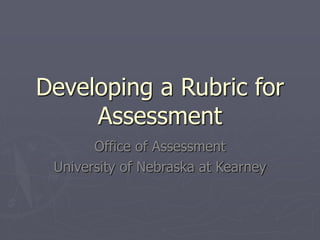
Developing Effective Rubrics for Assessment
- 1. Developing a Rubric for Assessment Office of Assessment University of Nebraska at Kearney
- 2. What is a rubric? ► A systematic scoring guideline to evaluate students’ performance (papers, speeches, problem solutions, portfolios, cases) through the use of a detailed description of performance levels. ► Used to get consistent scores across all students. ► Allows students to be more aware of the expectations for performance and consequently improve their performance. http://www.utexas.edu/academic/mec/research/pdf/rubricshandout.pdf
- 3. Why do we use rubrics for assessment? ►A rubric is a flexible tool that can be used to measure student learning related specifically to a department’s objectives. ►Because rubrics provide descriptions of each score level, it is easier for different faculty to use a rubric to grade consistently across students.
- 4. Rubric Characteristics For assessment purposes, we usually want to develop a rubric that: ► allows us to directly evaluate performance on program level student learning outcomes. ► is general enough that it can be used for different assignments (e.g. papers may be collected from different courses/faculty). ► is understood and agreed upon by faculty who will be using the rubric.
- 5. Step 1 in developing a rubric 1. Clearly define the assignment. What is the student expected to produce? What are the common expectations across instructors?
- 6. Step 2 in developing a Rubric 2. Consider what student learning outcomes will be assessed. Often with a culminating project, students are expected to demonstrate several of the department/program outcomes. For example, for a senior seminar paper, outcomes related to writing and critical thinking may be assessed, as well and more discipline- specific outcomes.
- 7. Step 3 in developing a Rubric 3. Determine the key criteria that you are interested in-- for example, for the senior seminar paper, what aspects of writing will be assessed? Coherence Organization Mechanics
- 8. Step 4 in developing a Rubric 4. Clearly define those key criteria. What do you mean by organization? What does organized writing look like?
- 9. Step 5 in developing a Rubric 5. Establish clear and detailed descriptors for each performance level for each criteria Determine what the different levels of performance look like within each criteria Use sample papers of high, mid and low performers to help It is usually easiest to begin by describing the highest level of performance Using specific language for the descriptors of performance levels increases the chances that multiple faculty members will apply the rubric in a similar manner.
- 10. Step 6 in developing a Rubric 6. Try out the rubric on a few students with several raters to see if the rubric works and gets consistent scoring from multiple raters.
- 12. Scales vs. Rubrics Below Expectation Meets Expectation Exceeds Expectation Citations The paper fails to cite sources using a consistent, formal, citation style Most follow a consistent style, although some contain minor errors or incomplete information All citations are complete, accurate, and consistently conform to a formal style
- 13. Initial Assessment Scale Criteria Poor Marginal Fair Good Excellent Introduction: Adequate literature review; sound rationale; clear statement of hypothesis/hypotheses 1 2 3 4 5 Method: Appropriate for hypothesis/hypotheses; adequate descriptions of participants, design, materials, and procedure. 1 2 3 4 5 Results: Appropriate use of statistics; adequate description of analyses 1 2 3 4 5 Discussion: Clear evaluation of hypothesis/hypotheses; connect to literature review/theory/ appropriate discussion of limitations, implications, and recommendations 1 2 3 4 5 Poster Style and Format: Well-organized; visually appealing, appropriate information density; readable font size and graphics; effective use of figures and illustrations 1 2 3 4 5
- 14. Improved Rubric
- 15. Using Rubrics ►Train evaluators ►Sample work should be scored ►Discuss scores and reach agreement ►More than on evaluator should score papers ►If two evaluators disagree a third decides ►Frequent disagreements on an item indicate the item needs to be revised or removed
- 16. Practice Select a “rubric” that is currently being used in your department: ► Is it a rubric or a scale? ► Are there multiple descriptions of the criteria (at least 3)? ► Are the descriptions clear and easy to use? ► Will other faculty agree on the descriptors?
- 17. Practice Rewrite the selected “rubric” to ensure it has multiple descriptors of the criteria (is not a scale), clear descriptors, and ratings that can be agreed upon by other faculty. Look at samples at: http:www.web.virginia.edu/iaas/assessment /assessrubrics.htm
- 18. Where to start Developing a rubric from scratch can be challenging. ► Get ideas by looking at what others have done ► Lots of sample rubrics for many disciplines at: http://www.winona.edu/air/rubrics.htm ► Online tool for developing rubric (with more samples): Rubistar for Teachers: http://rubistar.4teachers.org/index.php Online module for using the Rubistar at: http://www.vcu.edu/cte/resources/videos/Rubistar_tuto rial/index.html
- 19. Sources ►http://www.winona.edu/air/resourcelinks/ru bric_sampler.pdf (document of rubric development – long) ►http://www.utexas.edu/academic/mec/resea rch/pdf/rubricshandout.pdf - good description of rubrics with focus on general analytic rubrics for the purpose of assessment